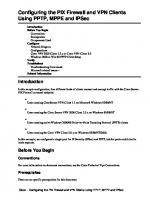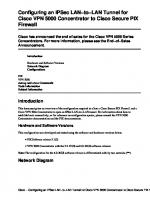Configuring the PIX Firewall and VPN Clients Using PPTP, MPPE and IPSec
321 100 29KB
English Pages 10
Table of Contents......Page 2
Prerequisites......Page 3
Network Diagram......Page 4
Configurations......Page 5
Troubleshooting Commands......Page 8
Microsoft related issues:-......Page 9
Related Information......Page 10
Recommend Papers

- Similar Topics
- Computers
- System Administration
File loading please wait...
Citation preview
Configuring the PIX Firewall and VPN Clients Using PPTP, MPP
Cisco − Configuring the PIX Firewall and VPN Clients Using PPTP, MPPE and IPSec
Table of Contents Configuring the PIX Firewall and VPN Clients Using PPTP, MPPE and IPSec.........................................1 Introduction.............................................................................................................................................1 Before You Begin...................................................................................................................................1 Conventions...............................................................................................................................1 Prerequisites...............................................................................................................................1 Components Used......................................................................................................................2 Configure................................................................................................................................................2 Network Diagram......................................................................................................................2 Configurations...........................................................................................................................3 Cisco VPN 3000 Client 2.5.x or Cisco VPN Client 3.0............................................................6 Windows 2000 or Win 98 PPTP Client Setup...........................................................................6 Verify......................................................................................................................................................6 Troubleshoot...........................................................................................................................................6 Troubleshooting Commands......................................................................................................6 Microsoft related issues:−..........................................................................................................7 Related Information................................................................................................................................8
i
Configuring the PIX Firewall and VPN Clients Using PPTP, MPPE and IPSec Introduction Before You Begin Conventions Prerequisites Components Used Configure Network Diagram Configurations Cisco VPN 3000 Client 2.5.x or Cisco VPN Client 3.0 Windows 2000 or Win 98 PPTP Client Setup Verify Troubleshoot Troubleshooting Commands Microsoft related issues:− Related Information
Introduction In this sample configuration, four different kinds of clients connect and encrypt traffic with the Cisco Secure PIX Firewall as tunnel endpoint: • Users running CiscoSecure VPN Client 1.1 on Microsoft Windows 95/98/NT • Users running the Cisco Secure VPN 3000 Client 2.5.x on Windows 95/98/NT • Users running native Windows 2000/98 Point−to−Point Tunneling Protocol (PPTP) clients • Users running the Cisco VPN Client 3.0.x on Windows 95/98/NT/2000. In this example, we configured a single pool for IP Security (IPSec) and PPTP, but the pools could also be made separate.
Before You Begin Conventions For more information on document conventions, see the Cisco Technical Tips Conventions.
Prerequisites There are no specific prerequisites for this document.
Cisco − Configuring the PIX Firewall and VPN Clients Using PPTP, MPPE and IPSec
Components Used The information in this document is based on the software and hardware versions below. • PIX Software Release 6.1.1 • CiscoSecure VPN Client 1.1 • Cisco VPN 3000 Client version 2.5 • Cisco VPN Client 3.X • Microsoft Windows 2000 and Windows 98 clients Note: This was tested on PIX Software Release 6.1.1 but should work on Release 5.2.X and 5.3.1. PIX Software Release 6.X is required for the Cisco VPN Client 3.X. (Support for the Cisco VPN 3000 Client 2.5 was added in PIX Software Release 5.2.X. The configuration also works for PIX Software Release 5.1.x, except for the VPN 3000 client part.) IPSec and PPTP/Microsoft Point−to−Point Encryption (MPPE) should be made to work separately first. If they do not work separately, they will not work together.
Configure In this section, you are presented with the information to configure the PIX Firewall and VPN clients using PPTP, MPPE and IPSec. Note: To find additional information on the commands used in this document, use the IOS Command Lookup tool.
Network Diagram This document uses the network setup shown in the diagram below.
Cisco − Configuring the PIX Firewall and VPN Clients Using PPTP, MPPE and IPSec
Configurations This document uses the configurations shown below. Cisco PIX Firewall PIX Version 5.2(3) nameif ethernet0 outside security0 nameif ethernet1 inside security100 enable password 8Ry2YjIyt7RRXU24 encrypted passwd 2KFQnbNIdI.2KYOU encrypted hostname goss−515A fixup protocol ftp 21 fixup protocol http 80 fixup protocol h323 1720 fixup protocol rsh 514 fixup protocol smtp 25 fixup protocol sqlnet 1521
Cisco − Configuring the PIX Firewall and VPN Clients Using PPTP, MPPE and IPSec
fixup protocol sip 5060 names access−list 101 permit ip 10.99.99.0 255.255.255.0 192.168.1.0 255.255.255.0 pager lines 24 logging on no logging timestamp no logging standby no logging console no logging monitor no logging buffered no logging trap no logging history logging facility 20 logging queue 512 interface ethernet0 auto interface ethernet1 auto mtu outside 1500 mtu inside 1500 ip address outside 172.18.124.152 255.255.255.0 ip address inside 10.99.99.1 255.255.255.0 ip audit info action alarm ip audit attack action alarm ip local pool bigpool 192.168.1.1−192.168.1.254 no failover failover timeout 0:00:00 failover poll 15 failover ip address outside 0.0.0.0 failover ip address inside 0.0.0.0 arp timeout 14400 nat (inside) 0 access−list 101 route outside 0.0.0.0 0.0.0.0 172.18.124.1 1 timeout xlate 3:00:00 timeout conn 1:00:00 half−closed 0:10:00 udp 0:02:00 rpc 0:10:00 h323 0:05:00 sip 0:30:00 sip_media 0:02:00 timeout uauth 0:05:00 absolute aaa−server TACACS+ protocol tacacs+ aaa−server RADIUS protocol radius no snmp−server location no snmp−server contact snmp−server community public no snmp−server enable traps floodguard enable sysopt connection permit−ipsec sysopt connection permit−pptp no sysopt route dnat crypto ipsec transform−set myset esp−des esp−md5−hmac crypto dynamic−map dynmap 10 set transform−set myset crypto map mymap 10 ipsec−isakmp dynamic dynmap crypto map mymap client configuration address initiate crypto map mymap client configuration address respond crypto map mymap interface outside isakmp enable outside !−−− CiscoSecure_VPNClient_key. isakmp key ******** address 0.0.0.0 netmask 0.0.0.0 isakmp identity address isakmp client configuration address−pool local bigpool outside !−−− ISAKMP Policy for Cisco VPN Client 2.5 or !−−− CiscoSecure VPN Client 1.1. isakmp policy 10 authentication pre−share
Cisco − Configuring the PIX Firewall and VPN Clients Using PPTP, MPPE and IPSec
isakmp policy 10 encryption des isakmp policy 10 hash md5 !−−− The 1.1 and 2.5 clients use Diffie−Hellman (D−H) !−−− group 1 policy (PIX default). isakmp policy 10 group 1 isakmp policy 10 lifetime 86400 ! !−−− ISAKMP Policy for VPN Client 3.0. isakmp policy 20 authentication pre−share isakmp policy 20 encryption des isakmp policy 20 hash md5 !−−− The 3.0 clients use D−H group 2 policy !−−− and PIX 6.0 code. isakmp policy 20 group 2 isakmp policy 20 lifetime 86400 vpngroup vpn3000−all address−pool bigpool vpngroup vpn3000−all dns−server 10.99.99.99 vpngroup vpn3000−all wins−server 10.99.99.99 vpngroup vpn3000−all default−domain password vpngroup vpn3000−all idle−time 1800 !−−− VPN 3000 group_name and group_password. vpngroup vpn3000−all password ******** telnet timeout 5 ssh timeout 5 vpdn group 1 accept dialin pptp vpdn group 1 ppp authentication pap vpdn group 1 ppp authentication chap vpdn group 1 ppp authentication mschap vpdn group 1 ppp encryption mppe auto vpdn group 1 client configuration address local bigpool vpdn group 1 client authentication local
!−−− PPTP username and password. vpdn username cisco password cisco vpdn enable outside terminal width 80
CiscoSecure VPN Client 1.1 1− TACconn My Identity Connection security: Secure Remote Party Identity and addressing ID Type: IP subnet 10.99.99.0 255.255.255.0 Port all Protocol all Connect using secure tunnel ID Type: IP address 172.18.124.152
Cisco − Configuring the PIX Firewall and VPN Clients Using PPTP, MPPE and IPSec
Pre−shared Key=CiscoSecure_VPNClient_key Authentication (Phase 1) Proposal 1 Authentication method: pre−shared key Encryp Alg: DES Hash Alg: MD5 SA life: Unspecified Key Group: DH 1 Key exchange (Phase 2) Proposal 1 Encapsulation ESP Encrypt Alg: DES Hash Alg: MD5 Encap: tunnel SA life: Unspecified no AH 2− Other Connections Connection security: Non−secure Local Network Interface Name: Any IP Addr: Any Port: All
Cisco VPN 3000 Client 2.5.x or Cisco VPN Client 3.0 Select Options > Properties > Authentication. Group−name and group password match the group_name and group_password on the PIX as in: vpngroup vpn3000−all password ******** Host−name = 172.18.124.152
Windows 2000 or Win 98 PPTP Client Setup You may contact the vendor who makes the PPTP client. For information on setting this up, see How to Configure the Cisco Secure PIX Firewall to Use PPTP.
Verify There is currently no verification procedure available for this configuration.
Troubleshoot This section provides information you can use to troubleshoot your configuration.
Troubleshooting Commands Note: Before issuing debug commands, please see Important Information on Debug Commands.
Cisco − Configuring the PIX Firewall and VPN Clients Using PPTP, MPPE and IPSec
PIX IPSec Debug • debug crypto ipsec − To see the IPSec negotiations of phase 2. • debug crypto isakmp − To see the Internet Security Association and Key Management Protocol (ISAKMP) negotiations of phase 1. • debug crypto engine − Shows the traffic that is encrypted PIX PPTP Debug • debug ppp io − Display the packet information for the PPTP PPP virtual interface. • debug ppp error − Display PPTP PPP virtual interface error messages. • debug vpdn error− Display PPTP protocol error messages. • debug vpdn packets − Display PPTP packet information about PPTP traffic. • debug vpdn events − Display PPTP tunnel event change information. • debug ppp uauth − Displays the PPTP PPP virtual interface AAA user authentication debugging messages.
Microsoft related issues:− • How to Keep RAS Connections Active After Logging Off − When you log off from a Windows Remote Access Service (RAS) client, any RAS connections will be disconnected automatically. To remain connected after logging off, you may enable the KeepRasConnections key in the registry on the RAS client. • User Is Not Alerted When Logging On with Cached Credentials − Symptoms − When you attempt to log on to a domain from a Windows−based workstation or member server and a domain controller cannot be located, no error message is displayed. Instead, you are logged on to the local computer using cached credentials. • How to Write an LMHOSTS File for Domain Validation and Other Name Resolution Issues − There may be instances when you are experiencing name resolution issues on your TCP/IP network and you need to use Lmhosts files to resolve NetBIOS names. This article discusses the proper method of creating an Lmhosts file to aid in name resolution and domain validation. Cisco − Configuring the PIX Firewall and VPN Clients Using PPTP, MPPE and IPSec
Related Information • IP Security (IPSec) Product Support Pages • PIX Command Reference • PIX Product Support Page • Requests for Comments (RFCs) • Configuring IPSec Network Security • Configuring Internet Key Exchange Security Protocol • Technical Support − Cisco Systems
All contents are Copyright © 1992−2002 Cisco Systems, Inc. All rights reserved. Important Notices and Privacy Statement.
Updated: Nov 04, 2002
Document ID: 14095
Cisco − Configuring the PIX Firewall and VPN Clients Using PPTP, MPPE and IPSec








![Cisco ASA and PIX Firewall Handbook [1 ed.]
9781587051586, 1587051583](https://ebin.pub/img/200x200/cisco-asa-and-pix-firewall-handbook-1nbsped-9781587051586-1587051583.jpg)
![Firewall Policies And VPN Configurations [1 ed.]
1590594924, 1597490377, 1597490881, 1931836124](https://ebin.pub/img/200x200/firewall-policies-and-vpn-configurations-1nbsped-1590594924-1597490377-1597490881-1931836124.jpg)